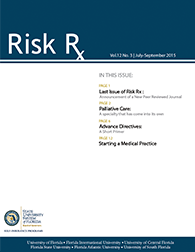
Download a PDF of the Current Issue 2015 Volume 12 Number 3 July- September
 Download the 2015 Volume 12 Number 3 July- September PDF
Download the 2015 Volume 12 Number 3 July- September PDF



• Improve the legibility of handwritten orders for medications and review all orders for accuracy and legibility after writing them.
• Note the “purpose” of a prescription to avoid confusion on the part of either pharmacists or patients.
• Use direct, computerized order entry systems, or print or type medication orders.
• Evaluate new electronic point-of-care software that not only prints legible prescriptions, but also alerts doctors to potential drug or allergy interactions, using up-to-date databases of medications that are linked to the patient’s records.
• Avoid using decimals, nonstandard abbreviations or the letter “u” (which can easily be misread as a zero) as shorthand for “units.”
• Consider preprinted prescriptions, on which physicians merely have to note the dosage and add their signature and DEA number.
• Take the time to educate patients or family members about the drug and dosage ordered. The patient should be asked to repeat the information to ensure they’ve understood.